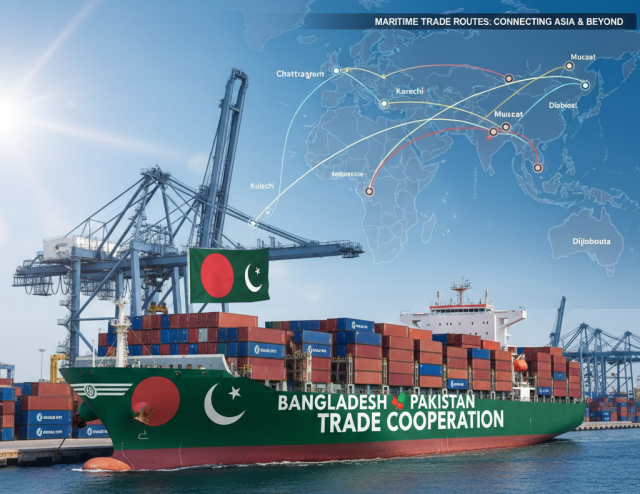From Our Staff Correspondent , Chattogram: A new commercial opportunity has emerged following the ninth Joint Economic Commission (JEC) meeting between Bangladesh and Pakistan. Pakistan has agreed to allow Bangladesh to use Karachi Port, one of the country’s major seaports. In return, Dhaka has sought duty-free and quota-free access for Bangladeshi products to the Pakistani market. This mutual proposal opens up fresh possibilities along trade routes in South and West Asia.
Karachi Port serves as Pakistan’s primary maritime gateway, facilitating extensive trade with the Middle East, Africa, and Central Asia. Shipping experts believe that if Bangladesh can access this port, it could reduce transport time and mitigate certain logistical risks, particularly supporting long-term export growth to markets in West Asia, Central Asia, and Africa.
Currently, Bangladeshi exports—including ready-made garments, leather goods, pharmaceuticals, ceramics, frozen foods, and jute products—primarily leave the country through Chattogram and Mongla ports, heading directly to the Middle East or Africa. Depending on the destination, these routes typically take 10 to 20 days.
Experts note that using Karachi Port could enable Bangladeshi products to reach West and Central Asian markets more efficiently via Pakistan. Transit routes could run from Karachi through Afghanistan or Iran to Central Asian countries such as Uzbekistan, Tajikistan, and Kyrgyzstan. Additionally, a direct maritime route from Karachi to the west coast of Africa offers an alternative trade pathway for Bangladesh.
However, experts caution that there are practical challenges. Goods would first need to be transported from Chattogram or Mongla to Karachi, increasing transit costs and potentially extending delivery times. Furthermore, Bangladesh would have to comply with Pakistan’s customs and transit regulations, which could add administrative complexity. Analysts suggest that while immediate financial gains may be limited, the route offers strategic advantages in the long term.
A former director of the Chattogram Chamber of Commerce commented, “Using Karachi Port is not a major economic gain for Bangladesh in itself, but it is a strategic step in trade. It can serve as an alternative route for exports to the Middle East and African markets.”
Bangladesh has so far faced several barriers accessing Central Asian markets via Pakistan, Afghanistan, and Iran. Karachi Port could help ease this route and is also seen as a symbolic step toward strengthening commercial ties in South Asia.
In conclusion, while direct economic benefits from using Karachi Port may be limited, the opportunity to open new transit routes, diversify export markets, and enhance strategic presence makes it a significant step for Bangladesh’s long-term trade strategy.











